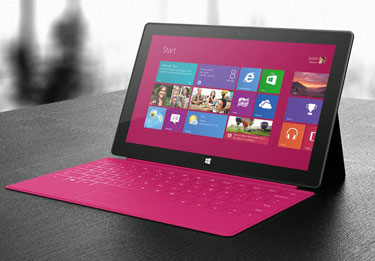Surface Value
Microsoft's Surface is light, fast and good-looking, and it offers greater opportunities than any of its rivals
The Surface is a curious device, and one of firsts. It’s the first device to launch with Windows RT. The first dedicated PC hardware product from Microsoft. The first tablet running Windows that anyone would actually want to buy. Seemingly stuck in a middle ground between laptops and tablets, Microsoft is marketing it as the device for everyone, to meet all needs, a hybrid of work and play, to take on Android and iOS at the game they’ve had two years to perfect. Can it succeed?
It’s the Surface’s hardware that arguably warrants the greatest praise. For a freshman effort, Microsoft has managed to produce a tablet that not only succeeds in being different from the iPad, but also one that, if anything, seems better made than Apple’s device. It certainly feels sturdier, with an incredibly dense quality, and it’s much better suited to surviving drops than an iPad. (At its launch, a member of the development team dropped a Surface from arm’s length on the stage, then picked it up to show the lack of damage — you won’t see this from Tim Cook and Co.)

Microsoft Surface with magenta cover
It has a stark, industrial aesthetic, with hard edges, angled sides and a matte finish. Crafted from magnesium using a proprietary process dubbed VaporMG, the casing is so smooth one could almost mistake it for plastic, but flip out the kickstand and you’re left in no doubt as to its metallic properties.
That kickstand alone is a standout feature. Under 1mm thick, it lies dormant on the back, forming part of the casing. Accessed through a small notch on the left-hand side, it flips out with a smooth, fast motion, locking into place with a metallic twang. Close it, and be met with a reassuring click modelled, according to Microsoft, on the noise made when closing the door on a luxury car. It’s certainly satisfying, and several friends sat, flipping the kickstand open and shut, before even turning the tablet on.
Underneath the kickstand, there is a microSDXC slot for expanding storage, which is useful as the 32GB model is left with just 16GB of usable space, and the 64GB model with 46GB, the rest consumed by Windows RT and the installed apps. Around the sides are the usual volume and lock buttons, and a 3.5mm headphone jack. Also included is a USB 2.0 port, which can be used with thousands of existing devices, from phones to printers and mice to microphones. More than once I found myself browsing the Web on my Surface, with my phone plugged in and charging, while transferring recent photos to the tablet. It’s an infinitely useful addition. Less so is the magnetic charger. Much like Apple’s MagSafe, it uses magnets to latch the power cable into place. Very useful, and very stylish, but the charger never locks into place on first attempt. Often it requires a degree of tilting and trial and error before it will lock into place, which with frequent use could lead to scratches surrounding the port as users repeatedly fight to charge the device. Once in place, however, it is secure, and the Surface charges quickly.
The bottom of the device is home to the magnetic connector for the Touch and Type covers. Microsoft has made a big show of the way the two join, and with good reason. I tested the Touch Cover, and it snaps into the tablet with ease, the two finding each other and pulling into place with a satisfying click. The Touch Cover itself is a 3mm thick protective cover, with a felt-like texture, containing a full capacitive keyboard.
There are no physical keys (there are on the Type Cover, which is 6mm thick). Instead the keys are printed onto the cover with indentations between each to mimic the island-style keyboard popular on most laptops. There’s even a track pad with buttons, though again it is capacitive and flat.
As for the actual typing experience? I’m honestly not sure. On a flat surface, such as a desk or table, it’s pretty good. After an initial period of trial and error, I was able to determine the appropriate amount of pressure for presses to register – more than an on-screen keyboard, less than a physical one – and after an hour or so, found I could maintain a decent word count per minute with minimal spelling mistakes.
The keys are well-spaced and reasonably sized, and the included track pad works well for navigating desktop mode. Typing on less stable surfaces, such as using the device on your lap, produces less accurate results, and I found myself using the Surface’s on-screen keyboard instead, which is excellent and takes its cues from Windows Phone’s similarly superb on-screen offering. A laptop replacement it isn’t, though for casual typing and note-taking, such as emails and lectures, it’s more than adequate. As proof, this entire review was constructed on the device, and though it didn’t take noticeably longer than on my laptop, the number of spelling mistakes was higher, and my fingers showed signs of fatigue due to the lack of key-travel. For serious typing, I suggest testing the Type keyboard to see if it better suits your needs.
The front of the Surface is dominated by a 10.6-inch, 1366×768 ClearType HD display, coated in tough Gorilla Glass 2, with a capacitive Windows logo sitting beneath it. (I’ll say this, if you want the best screen available on a tablet, get the Nexus 10, with its 2560×1600 screen and over 300ppi. The iPad manages 264ppi across 2048×1536, while the Surface makes do with just 148ppi. The numbers don’t tell everything, though, as the Surface still has one of the nicest screens available on a tablet, despite a lack of pixels.) Using Microsoft’s sub-pixel ClearType technology, text and images look sharp from a normal distance, aided by Windows’ ability to scale content across resolutions. Colors pop, and the Modern UI of Windows 8 looks glorious on the Surface, as Live Tiles flow and change on the homescreen, aided by fast response times from the touchscreen – though expect fingerprints to show as the Surface seems to lack the coatings some of its rivals have to prevent smudges from sticky fingers.
Video is where the screen really shines. The Surface has a 16:9 aspect ratio, allowing HD content to display without any black bands, filling all 10.6 inches. It’s a fantastic experience, and on more than one occasion when watching Netflix in bed, it felt like I’d taken my TV with me, so full is the viewable area. Compare it side-by-side with the iPad, and its 4:3 aspect ratio, and the Surface is the much better tablet for viewing video – though several Android tablets now offer 16:9 aspect ratios, and can offer full 1080p resolution for similar money, though with smaller 10.1-inch screens.
Sound on the Surface is merely adequate, with the volume never going as loudly as you’d expect, though it’s perfectly fine for watching a film or listening to music in a bedroom or living room – so long as they’re reasonably quiet. It’s enhanced with the addition of stereo speakers, situated on either side of the case, and the difference in sound compared with the mono speakers on many rivals is palpable, though I’d still advise an external speaker or headphones for the best experience.
Accessing your music and videos is made easy with Windows RT. RT is essentially Windows 8 designed for low-power ARM processors, the type found in most smartphones and tablets, and in this case a 1.3GHz quad-core NVIDIA Tegra 3. Powering it is a battery rated by Microsoft to offer comparable life to its rivals and in testing this has proven accurate. In an average day spent watching videos on YouTube, browsing the web, streaming music – users can enjoy free, ad-supported music streaming in the Xbox Music app (with an ad-free service available for $9.99 per month), a nice feature – writing in Word and scrolling through news stories and Twitter, I could finish the day with enough battery life to make it into the next morning. In fact, the Surface drains very little battery when sleeping, which removes the worry if you’re ever away from an outlet and don’t want it to die.
Support Metro Weekly’s Journalism
These are challenging times for news organizations. And yet it’s crucial we stay active and provide vital resources and information to both our local readers and the world. So won’t you please take a moment and consider supporting Metro Weekly with a membership? For as little as $5 a month, you can help ensure Metro Weekly magazine and MetroWeekly.com remain free, viable resources as we provide the best, most diverse, culturally-resonant LGBTQ coverage in both the D.C. region and around the world. Memberships come with exclusive perks and discounts, your own personal digital delivery of each week’s magazine (and an archive), access to our Member's Lounge when it launches this fall, and exclusive members-only items like Metro Weekly Membership Mugs and Tote Bags! Check out all our membership levels here and please join us today!























